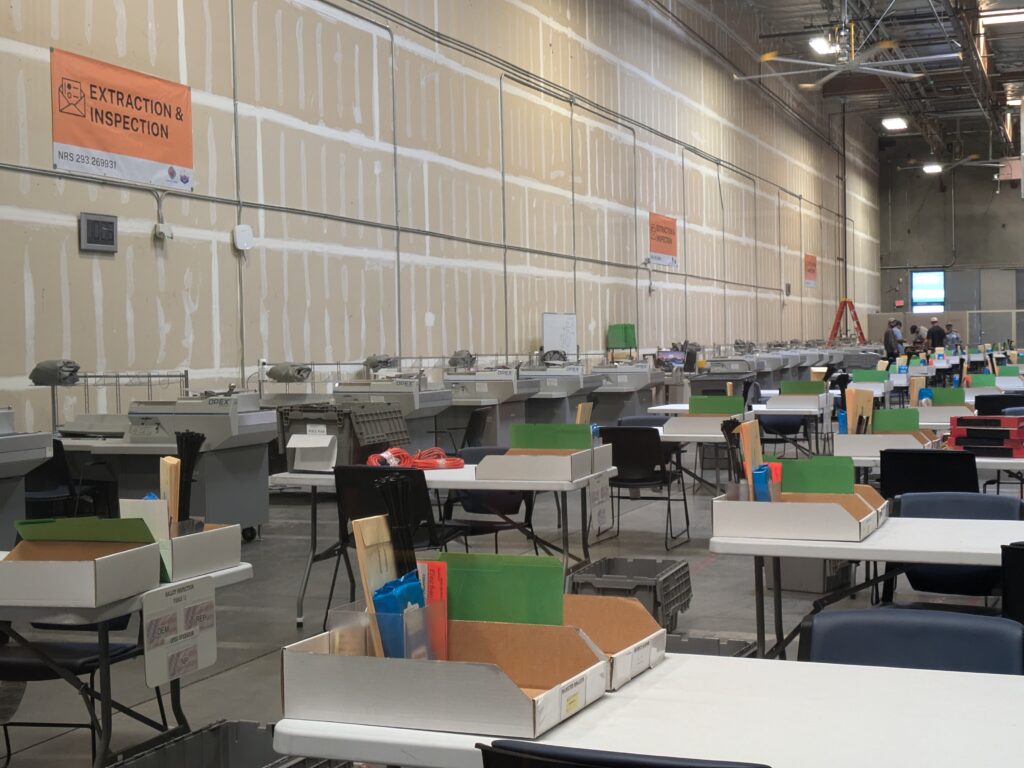Clark County Election Department on Oct. 16, 2024. (Photo: April Corbin Girnus/Nevada Current)
Counties in Nevada can begin processing and counting mail ballots beginning Monday. It’s one of several procedural changes that have been implemented by election officials in hopes of avoiding a repeat of the last presidential election, which left an impatient nation waiting on results from the Silver State for five days.
The race in Nevada, which abruptly switched to universal mail ballots in 2020 during the covid pandemic, was not called by media outlets until the Saturday after Election Day because of the close margins separating Donald Trump and Joe Biden and the significant numbers of mail ballots that had not been counted by the end of Election Day. Despite repeated reminders from election officials that mail ballots take longer to process because of the numerous steps involved, the seemingly slow pace of results on election night made Nevada the butt of jokes nationwide and, more problematically, added fuel to unfounded conspiracy theories about mass election fraud.
“We always hear (that) folks want to see things go faster, but what we really want is to keep the accuracy and integrity of the election while we provide efficiency,” said Lorena Portillo, the registrar of voters for Clark County. “I think we have found a happy medium and will be able to do that.”
One of the most significant changes to happen since 2020: State law now allows counties to begin processing and counting mail ballots 15 days prior to Election Day. This year that means Monday, Oct. 21.
During the 2022 general election, 51% of voters in Nevada used a mail ballot, and 64% of those mail ballots had been received by county election officials by the end of in-person early voting, according to turnout reports.
During the 2022 general election, 21% of voters cast ballots in person on Election Day and 28% during early voting.
Early voting ballots can be counted by counties beginning at 8 a.m. on Election Day.
Counties can also begin counting in-person Election Day votes as they come in, another change from prior years when counting began after polls closed.
But one key thing hasn’t changed: No results will be released on Election Day until every polling place in the state has closed. That’s something set in state law. Polling places officially close at 7 p.m. on Election Day but anybody in line at that time is allowed to vote. (Polling place hours can also be extended via court order because of bad weather or other issues.)
In addition to making the processing more efficient, Clark County has more machines and a bigger staff than in 2020, according to Portillo, who spoke with media Wednesday. The county hires about 3,000 temporary employees during election season.
A mail ballot’s journey, step by step
First, a mail ballot must be received by county election officials. Voters can return their ballots via the United States Postal Service, or they can drop them off at a ballot dropbox. The state in its official turnout reports does not differentiate between ballots returned through the mail and those delivered to a dropbox.
Once those ballots are received by the county election department, they are prepared for processing. This means the still-closed mail ballot envelopes are scanned, which captures the signature on them.
Then comes signature verification. The verification process begins with an automatic signature recognition program. Ballots whose signatures are not verified by the program move onto a manual signature verification area, where a bipartisan team compares the envelope’s signature with signatures on file from the DMV or electronic registration forms.
The still-closed mail ballot envelopes are then sorted. Envelopes whose signatures were not verified begin the signature cure process, wherein the county attempts to contact voters to let them know there is a problem with their ballot and allows them to remedy it. Envelopes with signatures that have been verified — either by the program or manually by the bipartisan team — move onto a process called “tray inspection.”
Inspectors verify and audit trays of mail ballot envelopes. The audited, still-closed envelopes are logged and then brought to what’s called the central counting board area.
The central counting board area is where each envelope with a verified signature is physically opened and the ballot inside removed. Ballots are flattened and visually inspected by bipartisan teams. The teams are looking to make sure only one ballot was included in the envelope and that a ballot is not damaged in a way that could affect it being read by the machine that tabulates votes.
If a ballot is physically damaged and unable to be read by a scanner, a bipartisan team will duplicate the ballot on a new ballot that can be read by the tabulation machine.
Each ballot is then imprinted with a unique number, which will be used during a post-election audit. Post-election audits are a routine part of the election process.
Only after all of that has occurred are the ballots run through a tabulation machine — a high-speed scanner that captures people’s selections for president all the way down to their local school board. Ballots that cannot be read by the scanner are logged and sent back to the central counting board for duplication.
Inevitably, some ballots are flagged for further inspection, or adjudication. This can happen when a voter selects more than one candidate (known as an “overvote”) or when their mark is not immediately clear. Those ballots go to a bipartisan team to be resolved.
After ballots are scanned and votes tabulated, ballots are placed into sealed boxes and stored in a secure area by county officials. The law requires that these boxes be kept for at least 22 months.

